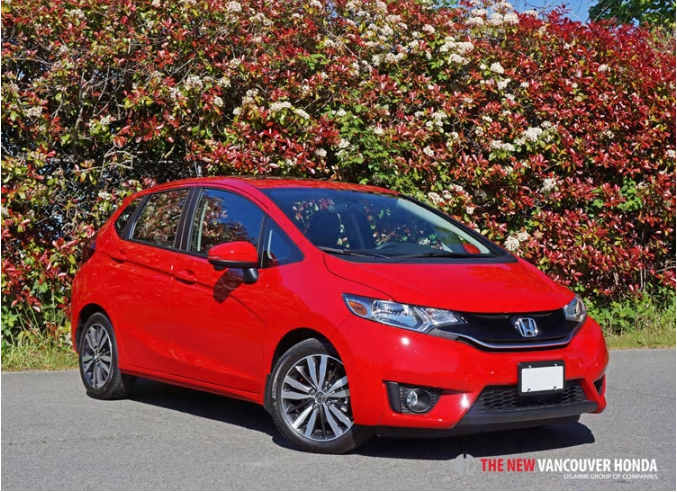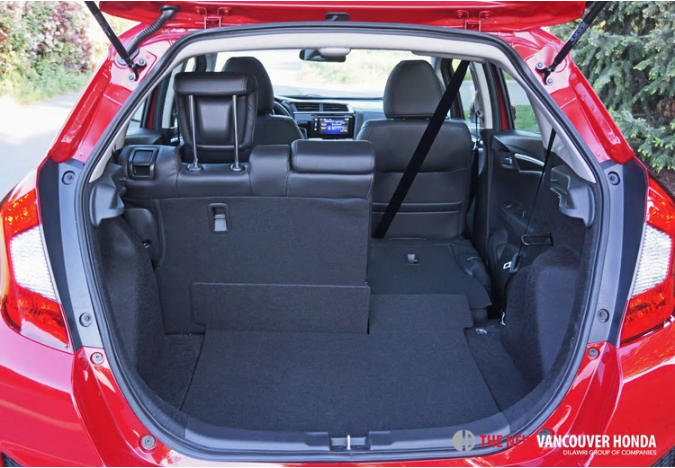2016 Honda Fit Road Test Review
August 02 2016, Vancouver Honda

Canada's Most Versatile Subcompact
I can't count how many times I've recommended Honda's Fit to those looking for a subcompact car, and not because it looks sharp, is fun to drive, is frugal on gas, well made, plenty comfortable, amply stocked with features, wholly reliable, and as safe as small cars come, but more so because it's one of the most versatile hatchbacks ever created.
Separating the Fit from mere mortal cars is the revolutionary "Magic Seat" system in back, which not only folds flat for hauling gear in the usual 60/40-configuration, albeit with a total of 1,492 litres available resulting in much more cargo space than any competitor, but you can also flip the lower cushions upward to convert the rear seating area into a cavernous cargo hold. This is especially useful for loading in taller items such as bicycles or large plants you don't want to get crushed. With the seats like this you still get 470 litres of luggage space behind their backsides, which of course remains the same if you're filling up the rear positions with three friends, kids, parents, grandparents, dogs, or whoever else you want to strap in.
The Fit was redesigned for the 2015 model year, but the Magic Seat system isn't new. It's now a slightly larger car that's allowed for a bit more room inside, the numbers being 139 litres of additional interior volume including 122 millimetres more rear legroom. Of note, if you'd like even more space and prefer an SUV's ride height and styling, Honda offers this same seating system in its new HR-V, but I've already covered that model multiple times so we'll leave it for now.
If carrying passengers and cargo in as many ways possible was all the Fit did well and the rest of the car was merely average I'd probably still recommend it, but such is far from the case. In fact, you'll get your first taste of its second most impressive attribute the moment you sit in the wonderfully comfortable driver's seat. Initially there's nothing but black lifeless screens ahead, that is until you press the bright red start button and all those digital panels come alive in sharp contrast, full colour and high resolution. The primary gauges include a speedometer at centre, tachometer to the left, and a fuel meter along with other readouts including a trip computer to the right, the latter controllable via steering wheel switchgear that also redundantly operates audio, phone, voice-activation, multi-information display, and cruise functions.
What's more, over on the centre stack is a large infotainment display up top, my tester's including navigation, a multi-angle backup camera with active guidelines, plus the usual audio, phone, and vehicle settings, as well as loads of included and downloadable apps. Just below is a purely touch-sensitive dual-zone auto HVAC system that's so far beyond anything else available in the mainstream volume-branded subcompact class it's shocking
As you may have guessed the car I was driving wasn't base, the DX model which starts at $14,790 plus freight and fees being considerably more down to earth. The version tested here is in $21,590 top-line EX-L Navi trim, upgraded to $22,890 thanks to an optional automatic CVT.
The EX-L Navi gets a lot of nice satin-silver faux metal to brighten up the cabin, plus some exclusive features like leather upholstery, and a leather-wrapped shift knob to go along with the leather-clad steering wheel pulled up from lesser EX trim. Additionally there's the auto climate control, voice recognition and navigation-infused infotainment system noted before, not to mention the racy red pushbutton ignition, the latter combined with proximity-sensing access as well. Lastly, the top-line model's very capable stereo system incorporates satellite and HD radio, while its mirror housings are upgraded with a set of LED turn signals.
Some other highlights grandfathered up from lower DX, LX and EX trims include machine-finished 16-inch alloys with black painted pockets on 185/55 all-season tires, auto on/off multi-reflector halogen headlights, fog lamps, body-colour mirrors, door handles and rear spoiler, plus LED brake lights, heatable powered side mirrors, tilt and telescopic steering, one-touch turn signals, heatable front seats, a powered moonroof, a cargo cover, Bluetooth phone connectivity with audio streaming, a six-speaker 180-watt stereo with an aux plug and two USB ports, Siri Eyes Free, text- and email- capability, HondaLink Next Generation telematics, and Honda's class-exclusive and utterly brilliant LaneWatch display system that projects the car's passenger-side blindspot onto the infotainment screen when clicking the right turn signal.
Safety in mind, all Fits get an immobilizer, hill start assist, all the usual active and passive safety equipment including a full assortment of advanced airbags, and the list goes on, while the latter items and Honda's rigid ACE body structure help each and every Fit achieve a five-star crash test rating from the NHTSA, and a best possible "Good" rating in four of five IIHS categories; its small overlap front test received a second-best "Acceptable" rating, which is as good as it gets for mainstream subcompacts.
All Fit trims also come standard with Honda's direct-injection, 16-valve, DOHC, i-VTEC-enhanced 1.5-litre four-cylinder engine and a six-speed manual gearbox, although as noted earlier mine was upgraded to include its optional continuously variable transmission with, get this, paddle shifters. These came in especially handy when downshifting during sporty test runs, while they certainly allowed for more engagement when upshifting, although the CVT felt best when left to its own very smooth and capable devices. The engine accelerates well with a considerable 130 horsepower and more than reasonable 114 lb-ft of torque, the Fit fairly lightweight at just 1,201 kilos as tested or 1,177 kg with the manual, and therefore hardly much of a drag on the powertrain.
When pushed hard its MacPherson front and torsion beam rear suspension setup is quite sporting, helped somewhat by my tester's larger wheels and tires. Truly, the Fit holds its line through fast-paced corners admirably, which caused me to add more speed from one bend to the next, and so on, its road-holding surprisingly capable for such a small, tall car. Still, I doubt most buyers will ever find out, the majority I see driving by seemingly kept on a short leash, so to speak, their owners more likely concerned with fuel economy than attempting to replicate the speeds McLaren-Honda F1 drivers Fernando Alonso and Jensen Button achieve on a given race weekend.
As you might expect it's a light drinker, the Fit's five-cycle EnerGuide rating a claimed 7.3 L/100km city, 6.1 highway and 6.8 combined in top-line CVT trim, slightly better at 7.0 city, 5.7 highway and 6.4 combined in LX CVT guise, and thirstiest (albeit still ultra-efficient) at 8.1 city, 6.4 highway and 7.3 combined with the manual.
As for styling, the updated Fit is a lot more appealing than its predecessor, with sharper edges that include an F1-inspired front wing-like lower fascia and cool black mesh faux vents front and back, while my tester even included some glitzy chrome at each end. I often see Fits new and old fixed up by their owners, meaning the car has a certain sporting cachet that most others in the class don't, which, along with Honda's good name, helps to keep its resale values higher than average.
I'm sure by now you can appreciate why I recommend the Fit to subcompact buyers most often. It does everything required of a small car, plus it provides best-in-class electronics and what is by far the most versatile rear seat passenger/cargo setup in the industry. You really can't go wrong with the Honda Fit.



